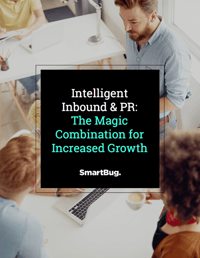
Your inbound marketing program is humming along. You have an interactive website full of infographics, you’re actively blogging, your social media accounts are buzzing with activity. You’re even publishing e-books on a regular basis. And everything you put out there is search engine optimized. You have effectively built a digital content-rich empire.
There’s nothing left to do—“If you build it, they will come,” right?
Not so fast. Even if your sales funnel is full, are you sure you’re reaching as much of your target audience as possible?
No, you can’t be. Because no matter your industry, your target audience is inundated with marketing content from every direction. Simply generating content doesn’t mean it magically appears before the eyes of your most coveted customers.
Intelligent Inbound® creates the content. Public relations gives it wings.
Why Intelligent Inbound and PR Work So Well Together
When implemented correctly, Intelligent Inbound and PR can form a happy marriage. Why? Because they have both similarities that align them with each other and differences that complete each other. Let’s dig a little deeper.
Similarities: Using Both Inbound Marketing and PR Help to Boost Your Brand
The primary similarity between PR and inbound marketing is that they both create a variety of content and messaging that supports brand building and corporate growth.
Intelligent Inbound involves building a digital content-rich empire that includes an interactive website full of infographics, videos, e-books, social media links, and an active blog. Public relations also relies on content-rich strategies, including media pitches, press releases, case studies, blog entries, and bylined articles.
As you can see, both practices are content-based. They even have some crossover in the type of content they produce, which makes it easy to get along and coordinate with each other’s efforts.
But if inbound marketing and PR are so similar, why would you need both? The answer lies in their differences.
Differences: Leveraging PR to Reach a Whole New Audience
Although both inbound and PR are content-centric, their content is different in type and delivery. And the way that content is distributed can have a huge impact on its effectiveness.
For example, inbound marketing may create articles to post on social media outlets like LinkedIn or on their corporate website’s blog. But the audience for those articles is limited to current customers, contacts, and prospects already in the sales channel.
PR, in contrast, develops content such as bylined articles for publication in third-party media outlets to put the message in front of a whole new set of prospects. Disseminating content to the public through third-party media outlets not only increases the size of the audience, but it also helps to validate a brand or establish a company as a thought leader in its industry. Thus, PR fills some important gaps and “completes” an inbound marketing program.
How to Put a PR Plan to Work for Your Inbound Marketing Strategy
You’ve invested a lot of time, money, and brainpower into your content. You’ve built a strong brand, refined your messaging, and developed many sources of great content that effectively tell your story.
So why is it just sitting on your website waiting to be discovered?
That content is a valuable commodity, and it should receive some well-deserved attention. The key is a PR program that is centered around a strong media relations plan.
Promote Inbound Content
PR professionals are relationship builders, and they know how to get their clients in front of the right people who can push them to the next level. PR pros already have media contacts they know and trust. They will not only let the media know your content exists, but they’ll also work with their editorial contacts to get it seen—and that is crucial.
Getting a link to your content in a news article exposes you to a built-in audience of subscribers and unique online visitors per month (UVPM), putting you one click away from a large pool of new prospects. Why not give your content that extra push for increased exposure?
Build Thought Leadership
It’s not just your Inbound marketing content that deserves exposure. Your company also has industry experts who know their business inside and out. They are innovators and thought leaders. After all, they’re the geniuses behind your products and services. Why keep them hidden between the walls of your office?
A good media relations plan will not only get your content noticed, but it will also shine a spotlight on your most talented executives. PR pros know what their media contacts are writing about, and they can set your executives up for interviews to provide quotes for the next big article covering your industry. Not only can an interview lead to your new industry star being quoted in an article, but sometimes the reporter will also write an entire article about your product or service—which puts your executives on the map as industry thought leaders and positions your company as an expert in its field.
Secure Articles and Op-Eds
Now that both your content and your experts are garnering media attention, it’s time to shoot for the stars and score the ultimate prize: a bylined article. This is an editorial piece written by (or for) your company that is credited to one or your top executives. Although it is educational in nature, a bylined article allows your company to control the message and tell its story in a persuasive way to a captive audience.
This may sound like a lot of work, but it really isn’t. Your expert is already a wiz at discussing the subject at hand. Once the article is published, not only do you have more validation that your company is leading in its space, but you also have more content and sales collateral at your fingertips.
Drive Traffic with Press Releases
Press releases seem old-school, but contrary to popular belief, the decades have hardly dented their efficacy. When deployed strategically, press releases can drive significant traffic to your inbound marketing or sales assets (e.g., homepage, e-commerce site, and social media profile).
To ensure success, just do your homework. Craft only high-quality, accurate, and compelling press releases (for product launches, community events, joint ventures, and so on). News outlets will be more than happy to publish. Don’t forget to optimize the copy for online search.
Building Success with an Integrated Approach to PR and Inbound Marketing
PR remains relevant today and can deliver significant ROI via its digital-era iterations, such as influencer marketing, brand validation, increasing website domain authority, link building, and social media reputation. By combining PR and inbound marketing, you cover the entire spectrum of strategies needed to keep organizations relevant and businesses progressing. From brand awareness and admiration to product consumption and advocacy, PR and inbound marketing turn on all the green lights for responsive, favorable, and sustained consumer behavior toward a brand.
This post was originally published in June 2020 and has been updated since.

About the author
Katharine Quaranta Katharine is a public relations manager based out of Youngstown, Ohio. She has a track record of building strong relationships with reporters and writing copy that resonates with the intended audience, be that customers, media, or employees. Over the years, she has also worked to plan, develop and execute many public relations plans as well as lead-generation strategies and campaigns. Read more articles by Katharine Quaranta.
























